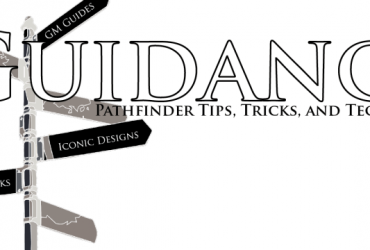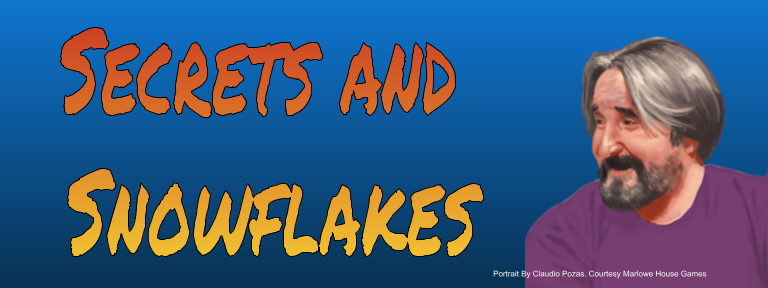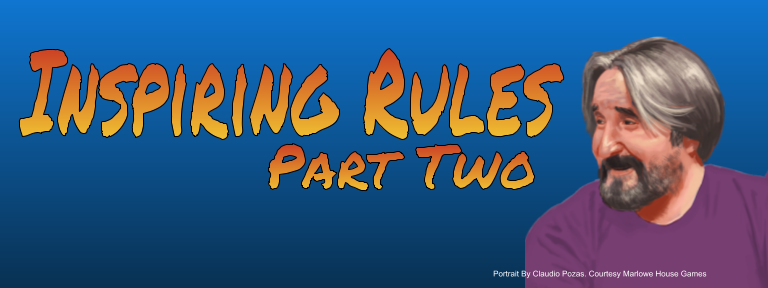Character development begins with an effective background and progresses through the entire life of a campaign. About a month ago I talked about character backgrounds and offered suggestions for GMs and players to effectively integrate those backgrounds into the campaign. Most of that advice came down to good communication. As a campaign progresses players and GMs should continue talking about (and likely expanding on) each character’s background and how it impacts the story’s current events.
Before the Campaign Begins
That previous blog prompted conversation elsewhere about running a session zero. In other words a game session prior to actual campaign play dedicated to settling on house rules, laying the groundwork for the campaign, and creating characters. I really like this approach and encourage groups to adopt it when possible.
One of the first things you’ll want to do during a session zero is to set some of the out-of-game expectations. Important things like: where and how often are you getting together to play, what time game will start and what time should everyone arrive. And sometimes most importantly who brings the snacks. I trust many of you will be playing with an established group and already have the answers to most of those burning questions. If you need advice on addressing those issues check out the Pathfinder Game Mastery Guide for suggestions.
In addition to these out-of-game conversations, there’s a lot of narrative value in a session zero. Begin with an overview of the campaign setting. Even with a published setting or an AP there is a lot of unexplored space and you can really increase player buy in if you have them help you fill that in. Lucy is planning to run Rise of the Runelords, she knows that in later chapters the heroes will venture out and see much of Varisia but more importantly the players will need to buy into Sandpoint. So she spends a little time filling in the players on this part of the campaign world spending most of her time discussing Sandpoint and some of its more interesting NPCs. A tiny preview of who the Runelords were might not go amiss here too, just so the players have an inkling of what’s at stake should the Runelords rise.
The adventure path, Rise of the Runelords is a return to basics. PCs will spend a lot of time exploring dungeons making discoveries but investigations will not be confined to ancient ruins. Player’s should expect some urban adventure opportunities and some overland travel and wilderness adventuring. This AP offers a little something for almost every character niche. It doesn’t hurt to spoil this a little at this point. I’m not saying Lucy should give a blow by blow of where the PCs will go or what they’ll face but letting them glimpse a little of the campaign’s direction will help them make good character choices.
Which brings us to creating a group of heroes. You need to be focused on making a team. Players and GM should decide on which roles will likely be important to successfully completing the campaign. This might be classes but typically is more general than that. In Rise of the Runelords, you might just want to stick to the basics and say: “Arcane Caster,” “Healer,” “Locks and Traps Expert,” “Wilderness Expert,” “Support,” and “Muscle.” While these look a little like classes they’re broader than that. With so many official class and archetype options even these basic roles could be filled in a number of ways. In an urban game of con-artists and rogues, the roles might look even less like classes and include options like “Face,” “Lock’s & Traps Expert,” and “Fence.” The point here is to make sure every PC has a unique place in the party and something they can do that makes them valuable to the group. You want ever character in this ensemble to have an opportunity to shine.
Hook your character concepts back into elements of the campaign from the first step. Maybe Charles wants to play a half-orc investigator with a troubling secret in her mysterious past. Lucy getting some ideas for later in the campaign might suggest Charles hail from Kaer Maga. Lucy’s brother may wish to play a hermit-Shoanti druid from just outside of Sandpoint filling “Wilderness Expert” role. You should also spend some time connecting the characters to each other. Did Marci’s Varisian bard Meet Pat’s gunslinger in Caliphas? A shared history can really help draw the players in and get them excited.
“This is just like Caliphas all over again.”
“You and I remember Caliphas very differently.”
But what if we just want to make a band of strangers who meet during the events of the Swallow Tail Festival. This is often cited as a reason to not run a session zero. I disagree. I suggest this is an opportunity to leverage the best aspects of a session zero. Of course, this means you have more work ahead of you. Look at the crew of Serenity in Firefly some of them have shared backstories and others meet for the first time in the pilot. All together they are frequently dysfunctional but that’s by the writer’s design rather than happenstance. Everyone in the crew still has a role to fill and gets a chance to shine.
Then we should talk Jayne. Without planning, a character like Jayne could derail an entire campaign and even cause it to end in hard feelings between the players. That said Jayne fuels a lot of great humor and drama. It just requires planning. The Jayne player should tell the other players up front what he’d like to play. All the player’s (including the GM) should work together to set boundaries for the character. Maybe Jayne’s player needs to get permission from the other players before he does something particularly treacherous or foolish. Whatever the mechanism it should be established now in session zero.
Similarly, if any of the players want to have a romantic relationship that should be discussed now too. A relationship like Zoe and Wash have is pretty easy. The boundaries are mostly self-explanatory and PG rated. The romantic tension between Kaylee and Simon would be a little bit more complex but not horribly so. However, the train-wreck tension between Mal and Inara requires a lot of upfront discussion of boundaries and expectations. Since name calling is often a part of this relationship you should also decide up front if there are any slurs that should be avoided as a part of these exchanges even if they would be okay if used in other ways during the campaign.
Beyond the narrative value and the importance of establishing campaign expectations there are a few mechanical questions the GM and players will want to address during this session like what rulebooks are valid for play, whether you’ll be using 3rd party rules, and how you’ll make characters. Because we still haven’t made characters yet. Talk about house rules…will you be using any optional rules such as point buy, the unchained classes, traits, or hero points?
Finally, once all the mechanical concerns are addressed the players should start making their characters. Try to keep the conversations going keep digging into who these characters are and how they fit together (or will fit together once they meet) and what their place in the world is.
In my experience, session zeroes offer groups the opportunity to make the coming campaign better through improved communication from the start. Please feel free to share your tips or experiences with session zero games here in the coments.





